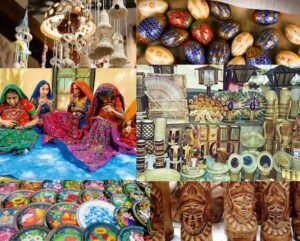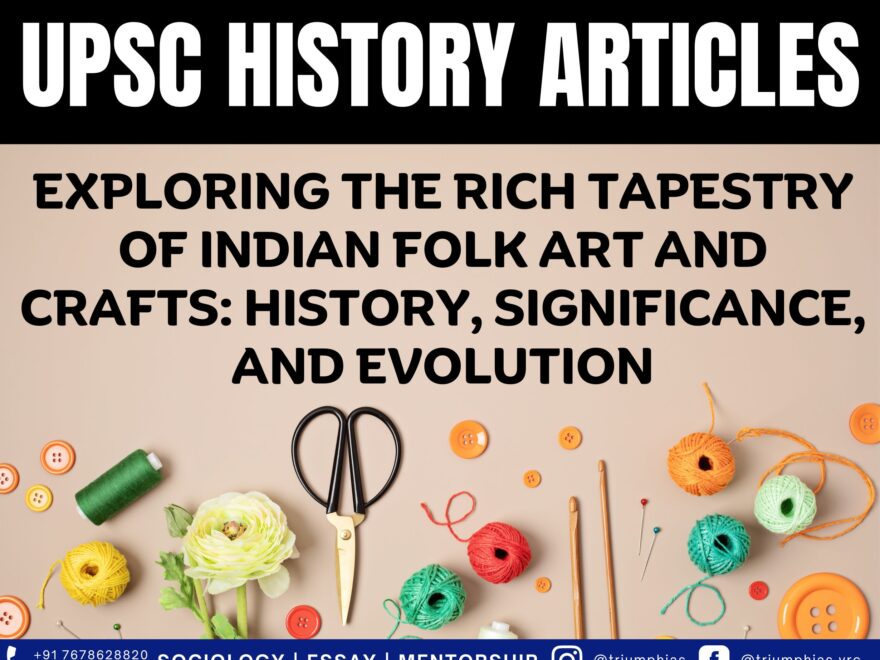Folk Art and Crafts
(Relevant for Historical Section of General Studies Paper Prelims/Mains)

Folk Art and Crafts
India is renowned for its manifold and dynamic culture, a reflection evident in its artistic and handicraft traditions. The country’s folk art and crafts boast a culturally affluent legacy that vividly illustrates the breadth of Indian heritage. These artistic expressions have been transmitted across successive generations, maintaining a crucial function in upholding India’s distinct cultural essence.
History and Significance of Indian Folk Art and Crafts
Indian folk art and crafts boast an extensive history that dates back to ancient times. Crafted by local artisans and craftsmen, these art forms utilize natural materials and age-old techniques to give rise to distinctive and intricate designs.
Folk art and crafts held a frequent purpose in adorning homes, temples, and public spaces, contributing significantly to religious and cultural ceremonies. Distinct regions of India each possess their own exclusive variations of folk art and crafts, mirroring the vastness of Indian culture. Some of the most prominent Indian folk art and crafts encompass:
- Madhubani Painting: Originating from Bihar’s Mithila region, Madhubani painting is a traditional Indian art form employing natural dyes and pigments to produce intricate patterns. These paintings often narrate mythological tales and scenes from daily life, characterized by bold outlines and vibrant colours.
- Warli Painting: Indigenous to the Maharashtra-Gujarat border region, Warli painting is tribal art marked by its utilization of geometric shapes and simple lines to depict everyday occurrences like hunting, farming, and fishing.
- Pattachitra Painting: Hailing from Odisha, Pattachitra paintings employ natural pigments, renowned for their detailed precision and vibrant hues. Typically illustrating stories from Hindu mythology, these artworks are an integral part of religious rituals.
- Block Printing: This popular technique, employed extensively in India for textiles and clothing, involves intricately carving designs onto wooden blocks. These blocks are then used to imprint fabrics with natural dyes.
- Gond Paintings: Originating in Madhya Pradesh, Gond paintings feature vibrant colours, dots, lines, and folk narratives. They depict flora, fauna, gods, myths, and legends.
- Kalamezhuthu: Hailing from Kerala, Kalamezhuthu paintings present ritualistic themes with symmetrical patterns, created using organic powders. They often depict Hindu deities, especially goddesses.
- Phad: A product of Rajasthan, Phad paintings uses horizontal scrolls, vivid colours, and narrative themes to showcase folk heroes, epics, and legends.
These examples barely scratch the surface of the multitude of Indian folk art and crafts. Each variety exhibits its distinct style, historical context, and significance, all of which have been pivotal in safeguarding India’s cultural legacy.
Evolution and Influence of Indian Folk Art and Crafts
- Indian folk art and crafts have undergone transformation over time, mirroring shifts in Indian society and culture.
- For instance, the shift from natural pigments and dyes to synthetic colors, and the adaptation of age-old techniques to contemporary materials and technologies signifies notable changes.
- Nonetheless, despite these adaptations, folk art and crafts retain their significance within Indian culture.
- Moreover, these traditional art forms have cast an impact on modern art and design.
- Numerous contemporary artists and designers draw inspiration from classic Indian art forms, skill fully infusing their work with the designs and motifs inherent in these traditions.
- Take, for example, Indian textiles and garments, which have garnered global popularity. Many designers have embraced traditional block printing methods to fashion innovative clothing designs.
Indian folk art and crafts have a rich cultural heritage that showcases the diversity of Indian culture. These art forms have been passed down through generations, and they continue to play a vital role in preserving India’s cultural identity. Each of these art forms has its own unique style, history, and significance, and they have influenced modern art and design. Indian folk art and crafts are an essential part of Indian culture, and they will continue to play an important role in preserving India’s cultural heritage for generations to come.
Sample Question for UPSC Sociology Optional Paper:
Question 1: What role do Indian folk art and crafts play in cultural and religious ceremonies?
Answer:
Indian folk art and crafts contribute significantly to religious and cultural ceremonies by adorning homes, temples, and public spaces, and serving as expressions of regional and religious identity.
Question 2: How have Indian folk art and crafts evolved over time?
Answer:
Indian folk art and crafts have adapted to shifts in society and technology, such as the transition from natural to synthetic pigments, while retaining their cultural significance.
Question 3: Discuss the influence of Indian folk art on modern art and design.
Answer:
Indian folk art has significantly influenced modern art and design, inspiring contemporary artists and designers to incorporate traditional motifs and techniques into their work.
Question 4: What is the significance of regional variation in Indian folk art and crafts?
Answer:
The regional variation in Indian folk art and crafts showcases the diversity and richness of Indian culture, as each region has its own unique style, history, and significance.
Question 5: How do natural materials feature in traditional Indian folk art and crafts?
Answer:
Natural materials like organic pigments and dyes, wooden blocks, and natural fibers are commonly used in traditional Indian folk art and crafts, emphasizing their connection to the environment and local resources.
To master these intricacies and fare well in the Sociology Optional Syllabus, aspiring sociologists might benefit from guidance by the Best Sociology Optional Teacher and participation in the Best Sociology Optional Coaching. These avenues provide comprehensive assistance, ensuring a solid understanding of sociology’s diverse methodologies and techniques.
Indian Folk Art, Indian Crafts, Madhubani Painting, Warli Painting, Pattachitra, Block Printing, Gond Paintings, Kalamezhuthu, Phad, Cultural Heritage, Indian Culture, Traditional Art Forms, Folk Art, Indian Crafts, Crafts, Indian Folk Art, Indian Crafts, Madhubani Painting, Warli Painting, Pattachitra, Block Printing, Gond Paintings, Kalamezhuthu, Phad, Cultural Heritage, Indian Culture, Traditional Art Forms, Folk Art, Indian Crafts, Crafts,

Choose The Best Sociology Optional Teacher for IAS Preparation?
At the beginning of the journey for Civil Services Examination preparation, many students face a pivotal decision – selecting their optional subject. Questions such as “which optional subject is the best?” and “which optional subject is the most scoring?” frequently come to mind. Choosing the right optional subject, like choosing the best sociology optional teacher, is a subjective yet vital step that requires a thoughtful decision based on facts. A misstep in this crucial decision can indeed prove disastrous.
Ever since the exam pattern was revamped in 2013, the UPSC has eliminated the need for a second optional subject. Now, candidates have to choose only one optional subject for the UPSC Mains, which has two papers of 250 marks each. One of the compelling choices for many has been the sociology optional. However, it’s strongly advised to decide on your optional subject for mains well ahead of time to get sufficient time to complete the syllabus. After all, most students score similarly in General Studies Papers; it’s the score in the optional subject & essay that contributes significantly to the final selection.
“A sound strategy does not rely solely on the popular
Opinion of toppers or famous YouTubers cum teachers.”
It requires understanding one’s ability, interest, and the relevance of the subject, not just for the exam but also for life in general. Hence, when selecting the best sociology teacher, one must consider the usefulness of sociology optional coaching in General Studies, Essay, and Personality Test.
The choice of the optional subject should be based on objective criteria, such as the nature, scope, and size of the syllabus, uniformity and stability in the question pattern, relevance of the syllabic content in daily life in society, and the availability of study material and guidance. For example, choosing the best sociology optional coaching can ensure access to top-quality study materials and experienced teachers. Always remember, the approach of the UPSC optional subject differs from your academic studies of subjects. Therefore, before settling for sociology optional, you need to analyze the syllabus, previous years’ pattern, subject requirements (be it ideal, visionary, numerical, conceptual theoretical), and your comfort level with the subject.
This decision marks a critical point in your UPSC – CSE journey, potentially determining your success in a career in IAS/Civil Services. Therefore, it’s crucial to choose wisely, whether it’s the optional subject or the best sociology optional teacher. Always base your decision on accurate facts, and never let your emotional biases guide your choices. After all, the search for the best sociology optional coaching is about finding the perfect fit for your unique academic needs and aspirations.
To master these intricacies and fare well in the Sociology Optional Syllabus, aspiring sociologists might benefit from guidance by the Best Sociology Optional Teacher and participation in the Best Sociology Optional Coaching. These avenues provide comprehensive assistance, ensuring a solid understanding of sociology’s diverse methodologies and techniques. Sociology, Social theory, Best Sociology Optional Teacher, Best Sociology Optional Coaching, Sociology Optional Syllabus.
Best Sociology Optional Teacher, Sociology Syllabus, Sociology Optional, Sociology Optional Coaching, Best Sociology Optional Coaching, Best Sociology Teacher, Sociology Course, Sociology Teacher, Sociology Foundation, Sociology Foundation Course, Sociology Optional UPSC, Sociology for IAS,
Follow us :
🔎 https://www.instagram.com/triumphias
🔎https://www.youtube.com/c/TriumphIAS
https://t.me/VikashRanjanSociology
Find More Blogs
|
Scope of the subject and comparison with other social sciences |
|||
|
|
|
|
Modernity and social changes in Europe |


3 comments